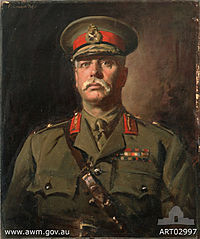- Charles Frederick Cox
-
Charles Frederick Cox 
Portrait of Brigadier General Charles Cox drawn in 1921Nickname Fighting Charlie Born 2 May 1863
Pennant Hills, New South WalesDied 20 November 1944 (aged 81)
Croydon, New South WalesAllegiance  Commonwealth of Australia
Commonwealth of AustraliaService/branch Australian Army Years of service 1891 – 1923 Rank Major General Commands held New South Wales Lancers
3rd New South Wales Mounted Rifles
6th Light Horse Regiment
1st Light Horse Brigade
4th Light Horse Brigade
1st Cavalry DivisionBattles/wars Awards Companion of the Order of the Bath
Companion of the Order of St Michael and St George
Distinguished Service Order
Volunteer Decoration
Mention in Despatches (5)Other work Member of Australian Senate Major General Charles Frederick Cox CB, CMG, DSO, VD (2 May 1863 – 20 November 1944) was an Australian Army colonel and temporary brigadier general in World War I. He retired in 1930 as an honorary major general.
Contents
Early life and career
Charles Frederick Cox was born on 2 May 1863 at Pennant Hills, Sydney, NSW. He was educated in Parramatta and became a clerk with the New South Wales Railways traffic audit branch in 1881.
Cox enlisted in the New South Wales Lancers in 1891 and was commissioned as a lieutenant in 1894. In 1897 he was chosen to head a detachment of the regiment in the ceremonies for Queen Victoria's Diamond Jubilee. Promoted to captain later that year, he travelled to England again in 1899 in command of a squadron of the lancers for training with the British cavalry.
The squadron was training alongside the 6th Dragoon Guards (Carabiniers) at Aldershot, England, when the Boer War broke out. Cox volunteered himself and his squadron for service in South Africa. Some 70 of his men went to South Africa; another 31, for various reasons, did not, and returned to Australia. Cox and his volunteers arrived in Cape Town in December 1899.
The squadron saw only limited action throughout their first tour but did take part in the last major battle of the war, the Battle of Paardeberg on 18 February 1900. In May 1900, Cox was attached to the Inniskilling Dragoons, under the command of Major E Allenby.
The lancers returned to Australia in December 1900. Cox was promoted to major and given command of the newly formed 3rd New South Wales Mounted Rifles, with which he returned to South Africa in April 1901. In June he was made an honorary lieutenant colonel. In the latter half of 1901 Cox's regiment joined part of a force led by Colonel Michael Rimington. They covered 1,814 miles in 153 days. There was little action apart from the occasional skirmish but these cost the regiment 5 killed and 19 wounded.
While the British regulars had doubts about Cox's competence in 1899, by the end of the war in 1902 Cox had earned considerable accolades from Colonel Rimington. From his men he had earned the nickname "Fighting Charlie".
Cox remained with the lancers which became the 1st Light Horse in 1903. He became the commander in 1906 and was promoted to lieutenant colonel on 2 April 1908. In 1911 Cox was transferred to the unattached officer list.
World War I
In September 1914, Cox was appointed command the AIF's 6th Light Horse Regiment. The regiment trained in Sydney and Egypt before arriving at Gallipoli for dismounted service on 19 May 1915. Two days later, Cox was wounded by shrapnel while in his dugout. He was evacuated and did not rejoin his regiment until 1 July. When Brigadier General Chauvel took over the New Zealand and Australian Division on 19 September, Cox became acting commander of the 1st Light Horse Brigade. On 6 December 1915 the appointment became permanent and Cox was promoted to colonel and temporary brigadier general. He was to hold this post for the duration of the war.
The 1st Light Horse Brigade arrived back in Egypt on 28 December 1915. The brigade was sent to Wadi Natrun, south west of Cairo, to protect the Kataba Canal against the Senussi. On 11 February 1916, the brigade, less the 3rd Light Horse Regiment, entrained for Minia. They remained there until May, patrolling the area for signs of the Senussi.
In May Cox went to England on sick leave. He rejoined his brigade on 26 August 1916 on the Suez Canal front, where they now formed part of Chauvel's Anzac Mounted Division. Cox and his brigade took part in multiple actions during the Sinai and Palestine Campaign, including the Battle of Magdhaba, Battle of Beersheba and captured the town of Jericho.
Post war
Cox returned to Australia on 13 March 1919. In 1920 he was elected to the Senate as a Nationalist representing New South Wales, a seat he held until 1938. He travelled widely through New South Wales and became well known and popular. As a senator, he took an interest in defence policy, the development of the railway system, and the construction of the new national capital in Canberra.
Cox was appointed to command the 4th Light Horse Brigade in 1920, and then the 1st Cavalry Division in 1921. In 1923 he was transferred to the retired list with the rank of honorary major general. He died at Croydon on 20 November 1944 and was buried in the Carlingford Cemetery with full military honours.
See also
List of Australian Generals
References
Charles Frederick Cox Biography at General Officers of the First AIF
Categories:- 1863 births
- 1944 deaths
- Australian generals
- Australian military personnel of the Second Boer War
- Australian military personnel of World War I
- Companions of the Distinguished Service Order
- Companions of the Order of St Michael and St George
- Companions of the Order of the Bath
- Members of the Australian Senate for New South Wales
- Recipients of the Volunteer Decoration
Wikimedia Foundation. 2010.
